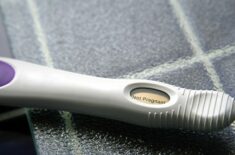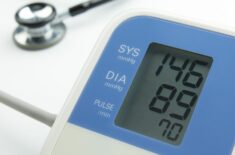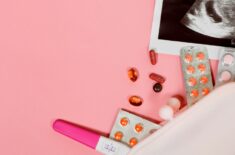Overview
Pregnant women might need as much as 10,000 IU of vitamin D supplements per day to significantly reduce the risk of some pregnancy complications due to vitamin D deficiency. (1)
The IOM (Institute of Medicine) recommends 400-600 IU (international units) daily intake of vitamin D for pregnant women.
However, studies show that this may not be enough to raise vitamin D levels in maternal serum. (2)(3)
But what happens if vitamin D is low during pregnancy?
After reading this article, you’ll know why it’s important to have adequate vitamin D in pregnancy. You’ll also learn which type is better and how much you’ll need for your pregnancy.
Importance of Vitamin D Supplementation During Pregnancy
Vitamin D in pregnancy is essential for your baby to grow strong bones, teeth, muscles, heart, kidneys, and nervous system.
That’s because vitamin D helps with the homeostasis (steady balance) of phosphorus and calcium in our bodies. These micronutrients are important in helping our bodies have healthy bones. Phosphorus also helps in our body’s energy production.
Because your baby depends on you to provide essential vitamins and minerals in your womb, you need to have an adequate supply.
Your baby is fully dependent on your maternal 25(OH)D (also known as calcifediol, the form of vitamin D produced in your liver) during pregnancy.
The 25(OH)D crosses the placenta and gets converted into 1,25(OH)2D (calcitriol) which is responsible for calcium and phosphate absorption in your baby’s body. (4)
The problem is that you may not be getting enough vitamin D from food or sunshine.
While the sun helps you produce vitamin D, you may not get enough sunlight, especially during autumn and winter months or if you stay indoors most of the time.
Clinical trials have shown that vitamin D supplementation can help increase vitamin D concentrations to lower the risk of some pregnancy complications due to deficiency, including gestational diabetes. (5)(2)(3)
Vitamin D Deficiency in Pregnancy
The prevalence of vitamin D insufficiency in pregnancy is high across the world: (6)(7)(8)(9)(10)(11)(12)(13)
- 99.6% in Indonesia
- 87% in New Zealand
- 85% in Brazil
- 80% in Australia
- 69% in the US
- 61% in Mexico
- 36% in the United Kingdom
- 31.5% in Canada
But maternal vitamin D deficiency during the antenatal (prenatal) period shouldn’t be ignored because it poses risks for both you and your baby. (14)
For moms, it could lead to:
- Gestational diabetes
- Preterm labor
- Postpartum depression
- High blood pressure
- Preeclampsia (a serious complication in pregnancy, characterized by high blood pressure with potential organ damage)
- Cesarean section
- Bone loss
- Poor weight gain
- Increased risk of recurrent/repeated miscarriages
Note that preeclampsia is a common cause of increased mortality (death) rates in pregnancy.
Babies born to moms with low maternal vitamin D status, tested as serum 25-hydroxyvitamin D, may have increased risks of: (5)(14)
- Small for gestational age
- Low birth weight
- Rickets (weak bones)
- Osteomalacia (soft bones and muscle weakness)
- Preterm birth
- Hypocalcemia (low calcium)
- Increased risk for infectious diseases
- Increased risk for autoimmune diseases
- Large fontanelle (baby’s soft spot on the head)
- High risk of heart failure
- Poor bone health and stunted growth
What Contributes to Vitamin D Deficiency?
Many people prefer to stay indoors to reduce the risk of skin cancer. But this might lead to vitamin D deficiency.
Sun exposure is needed so our bodies can produce vitamin D.
That’s why researchers recommend around five to 10 minutes of sunlight exposure a day so you may increase your vitamin D levels.
If you live in northern latitudes, you’ll also have a high risk of having vitamin D insufficiency, especially during the autumn and winter months.
But studies have shown that the incidence is also high in tropical Asian countries, such as Indonesia (99.6%). (8)
The following personal and cultural practices also lead to increased risk of vitamin D deficiency: (15)
- Low vitamin D intake
- Wearing protective clothing (covering arms and legs)
- Wearing veils and long dresses
- Excessive sunscreen use
- Staying indoors or less outdoor activities
- Vegetarians and vegans
Vitamin D deficiency shows links to obesity, with studies showing a high percentage of obese patients having low levels of the vitamin in their bodies. (16)
Moreover, as demands increase in the third trimester, vitamin D supplies in your body might be quickly used up by your baby.
Normal Vitamin D Levels in Pregnancy
The IOM (Institute of Medicine) defines normal vitamin D levels as serum vitamin D levels above 20 ng/ml (50 nmol/liter). (17)
It’s important to stay within these levels to maintain proper bone health for you and your baby. But supplementation may be the only way to achieve these levels for a healthier pregnancy and child health.
The Endocrine Society recommends measuring serum 25-hydroxyvitamin D levels as a diagnostic test for those at risk of deficiency.
Currently, there are no recommendations for routine screening, but many OBGYNs do routine tests for pregnant women in the US. Check with your OBGYN to confirm if this will be the case for you. (18)
How Much Vitamin D Should You Take During Pregnancy?
To reach stable levels of vitamin D in maternal serum, the IOM recommends a daily intake of 400-600 IU vitamin D for pregnant women.
But recent studies have shown that these recommendations might not be enough to meet the increased demands for vitamin D in your body.
Researchers recommend that pregnant women take 2,000 IU to 4,000 IU per day. (2)(3)
The Endocrine Society sets the limit at 10,000 IU of vitamin D per day. So don’t go beyond this recommended upper limit.
Vitamin D Food Sources
An important public health problem, there’s a need to address the problem of vitamin D deficiency on a global scale. In addition, researchers suggest vitamin D fortification to increase the nutritional value of foods.
It’s best to increase your intake of foods rich in vitamin D, even in early pregnancy.
Some foods rich in vitamin D include the following: (14)(19)
- Cod liver oil, 1 tbsp; contains 1,360 IU
- Herring, 3 oz; contains 1,383 IU
- Trout (rainbow), 3 oz; contains 645 IU
- Pink salmon, canned, 3 oz; contains 570 IU
- Catfish, 3 oz; contains 425 IU
- Mackerel, 3 oz; contains 306 IU
- Sardines, canned, 3 oz; contains 231 IU
- Cow’s milk, fortified, 8 oz; contains 120 IU
- Soy milk, fortified, 8 oz; contains 100 IU
- Orange juice, fortified, 8 oz; contains 100 IU
- Breakfast cereal, fortified, 1 cup; contains 40-80 IU
- Liver, beef, braised, 3 oz; contains 42 IU
- Egg yolk; contains 25 IU
Vitamin D is a fat-soluble vitamin. It’s good to take this along with a meal or snack high in healthy fats for better absorption.
Can I Take 60000 IU Of Vitamin D During Pregnancy?
The following are some of the ways you can get vitamin D supplementation: (14)
- Prescribed vitamin D2 supplements; contain 50,000 IU (max)
- Over-the-counter vitamin D3 supplements; contain 2,000 IU (max)
- Most prenatal vitamins; contain 400 IU
Studies show that supplementation above the current recommendations may better increase vitamin D levels in pregnant women. (20)
Effects of 400 IU to 4,000 IU Supplementation
A systematic review (2019) of randomized controlled trials from the Cochrane Database shows that supplementation from 600 IU to 4,000 IU may only make a little difference in lowering the risk of low birth weight, preterm labor, and preeclampsia.
But this may reduce the risk of gestational diabetes. (5)
Another clinical trial conducted in 2018 shows that daily supplementation of 4000 IU vitamin D3 may be safe for pregnancy and could help increase maternal concentrations without vitamin D toxicity. (21)
Effects of 10,000 IU Supplementation
Daily doses of over 10,000 IU of vitamin D may be needed to increase maternal vitamin D serum levels to normal levels. (3)
A 2013 randomized clinical trial compared with a placebo, published in the American Journal of Obstetrics and Gynecology, showed that supplemental vitamin D in doses up to 10,000 IU help maintain 25(OH)D serum level in the normal range during pregnancy, with a low likelihood of toxicity. (14)
Effects of 80,000 IU Supplementation
A 2001 clinical trial held in France showed that a single dose of 80,000 IU vitamin D given to pregnant women during the winter season, between the 27th and 32nd week of gestation, may be effective against vitamin D deficiency. (22)
The neonates (newborn babies) in the study did not show hypocalcemia (low calcium levels) or symptoms of vitamin D toxicity at birth.
Effects of 600,000 IU Supplementation
In 1981, a study published in Gynecologic and Obstetric Investigation showed that administering 600,000 IU of vitamin D during the 7th and 8th months of gestation may be more effective in raising levels of this vitamin in maternal serum and cord blood serum (for babies). (23)
Can Too Much Vitamin D Be Harmful In Pregnancy?
As shown in the studies above, higher vitamin D doses may be better at increasing maternal vitamin D status than lower doses. But exercise caution with these increased doses, and always consult with your doctor beforehand.
The IOM (Institute of Medicine) sets an upper limit of 4,000 IU/day intake of vitamin D for pregnant women, while the Endocrine Society recommends a higher upper limit of 10,000 IU/day. (2)
If you’re unsure who to follow, it’s best to discuss this with your doctor.
High doses may be better at increasing vitamin D levels in your blood but may lead to an increased risk of vitamin D toxicity (may cause kidney failure). (24)
However, vitamin D toxicity is rare and only observed in patients taking doses of over 10,000 IU per day for several months. (25)
Vitamin D Supplementation with Other Vitamins
Taking vitamin D supplements with calcium may reduce your risk of preeclampsia but could increase the risk of preterm birth. (5)
Do Prenatal Vitamins Have Enough Vitamin D?
Most prenatal vitamins contain 400 IU of vitamin D per tablet, but multivitamins might have lower concentrations. It’s important to check the label before choosing which one to buy proper vitamin D supplementation. (15)
But studies show that 400 IU of vitamin D may not be enough for pregnant women to reach the minimum serum vitamin D concentration. So, it’s essential to ask your doctor for recommendations on what supplements you might need to take. (26)
Does My Baby Need Vitamin D Supplements?
Babies also need vitamin D; so, you should continue taking vitamin D supplements while breastfeeding.
Researchers recommend at least 2,000 IU per day of vitamin D for breastfeeding moms. (27)
Clinical trials in pediatrics show that for children with vitamin D deficiency, a single dose of 50,000 IU may be safe and could raise 25(OH)D levels to normal levels. (28)
The AAP (American Academy of Pediatrics) recommends that exclusively breastfed babies be given 400 IU/day vitamin D supplements. (29)
REFERENCES
(1) https://www.ncbi.nlm.nih.gov/pmc/articles/PMC4449396/
(2) Mithal, A., & Kalra, S. (2014). Vitamin D supplementation in pregnancy. Indian journal of endocrinology and metabolism, Indian J Endocrinol Metab. 18(5), 593–596. https://doi.org/10.4103/2230-8210.139204 https://www.ncbi.nlm.nih.gov/pmc/articles/PMC4171878/
(3) Hollis BW, Wagner CL. Assessment of dietary vitamin D requirements during pregnancy and lactation. Am J Clin Nutr. 2004 May;79(5):717-26. doi: 10.1093/ajcn/79.5.717. PMID: 15113709. https://pubmed.ncbi.nlm.nih.gov/15113709/
(4) https://pubmed.ncbi.nlm.nih.gov/29533937/ (full text: https://www.karger.com/Article/FullText/487370)
(5) Palacios, C., De-Regil, L. M., Lombardo, L. K., & Peña-Rosas, J. P. (2016). Vitamin D supplementation during pregnancy: Updated meta-analysis on maternal outcomes. The Journal of steroid biochemistry and molecular biology, 164, 148–155. https://doi.org/10.1016/j.jsbmb.2016.02.008 https://www.ncbi.nlm.nih.gov/pmc/articles/PMC5357731/
(6) https://pubmed.ncbi.nlm.nih.gov/20060512/
(7) https://www.scielo.br/scielo.php?pid=S0103-05822015000300286&script=sci_arttext&tlng=en
(8) https://mji.ui.ac.id/journal/index.php/mji/article/view/1617
(9) https://pubmed.ncbi.nlm.nih.gov/29099117/
(10) https://pubmed.ncbi.nlm.nih.gov/23230904/
(11) https://pubmed.ncbi.nlm.nih.gov/26641010/
(12) https://pubmed.ncbi.nlm.nih.gov/16964296/
(13) https://pubmed.ncbi.nlm.nih.gov/11587255/
(14) Mulligan, M. L., Felton, S. K., Riek, A. E., & Bernal-Mizrachi, C. (2010). Implications of vitamin D deficiency in pregnancy and lactation. American journal of obstetrics and gynecology, 202(5), 429.e1–429.e4299. https://doi.org/10.1016/j.ajog.2009.09.002 https://www.ncbi.nlm.nih.gov/pmc/articles/PMC3540805/
(15) https://www.acog.org/clinical/clinical-guidance/committee-opinion/articles/2011/07/vitamin-d-screening-and-supplementation-during-pregnancy
(16) Vanlint. https://www.ncbi.nlm.nih.gov/pmc/articles/PMC3705328/
(17) LeBlanc. https://www.ncbi.nlm.nih.gov/books/NBK263420/
(18) Holick MF, Binkley NC, Bischoff-Ferrari HA, Gordon CM, Hanley DA, Heaney RP, Murad MH, Weaver CM; Endocrine Society. Evaluation, treatment, and prevention of vitamin D deficiency: an Endocrine Society clinical practice guideline. J Clin Endocrinol Metab. 2011 Jul;96(7):1911-30. doi: 10.1210/jc.2011-0385. Epub 2011 Jun 6. Erratum in: J Clin Endocrinol Metab. 2011 Dec;96(12):3908. PMID: 21646368. https://pubmed.ncbi.nlm.nih.gov/21646368/
(19) https://ods.od.nih.gov/factsheets/VitaminD-HealthProfessional/
(20) Bodnar LM, Platt RW, Simhan HN. Early-pregnancy vitamin D deficiency and risk of preterm birth subtypes. Obstet Gynecol. 2015 Feb;125(2):439-447. doi: 10.1097/AOG.0000000000000621. PMID: 25569002; PMCID: PMC4304969. https://pubmed.ncbi.nlm.nih.gov/25569002/
(21) https://pubmed.ncbi.nlm.nih.gov/30552064/
(22) https://pubmed.ncbi.nlm.nih.gov/11917727/
(23) Marya. https://pubmed.ncbi.nlm.nih.gov/7239350/
(24) https://www.msdmanuals.com/professional/nutritional-disorders/vitamin-deficiency-dependency-and-toxicity/vitamin-d-toxicity
(25) https://www.ncbi.nlm.nih.gov/pmc/articles/PMC2912737/
(26) Lee JM, Smith JR, Philipp BL, Chen TC, Mathieu J, Holick MF. Vitamin D deficiency in a healthy group of mothers and newborn infants. Clin Pediatr (Phila). 2007 Jan;46(1):42-4. doi: 10.1177/0009922806289311. PMID: 17164508. https://pubmed.ncbi.nlm.nih.gov/17164508/
(27) https://pubmed.ncbi.nlm.nih.gov/24344104/
(28) https://pubmed.ncbi.nlm.nih.gov/25582182/
(29) https://www.ncbi.nlm.nih.gov/pmc/articles/PMC4436962/












